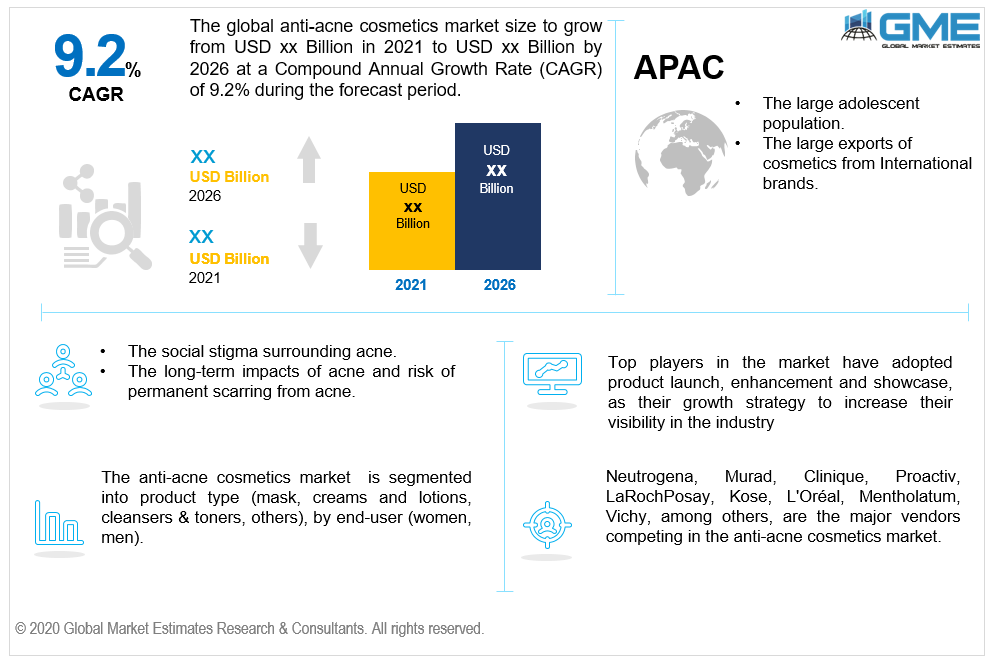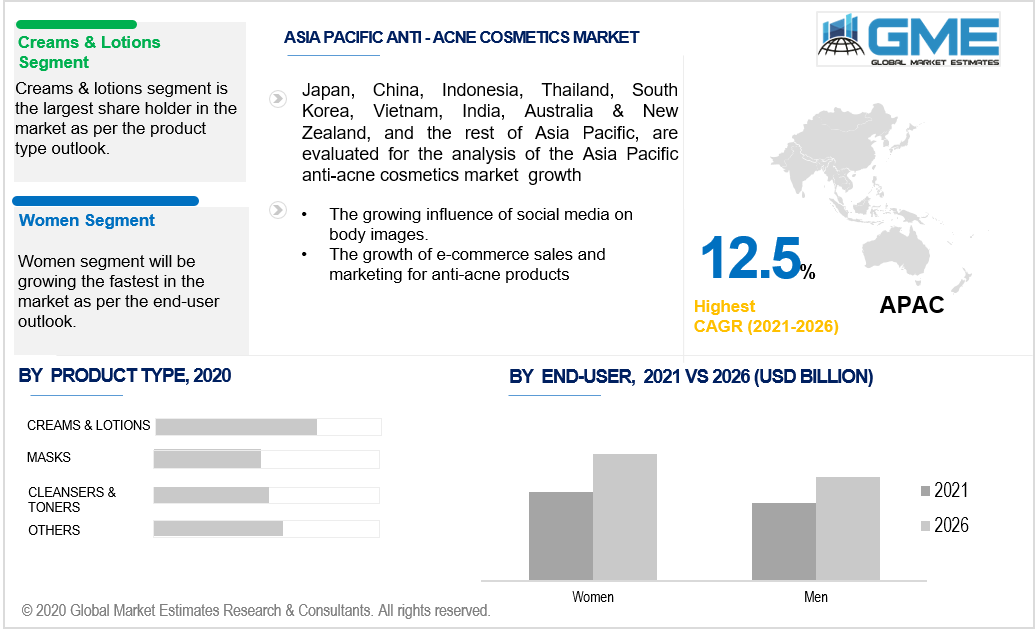
Global Anti-Acne Cosmetics Market Size, Trends, and Analysis - Forecast To 2026 By Product Type (Mask, Creams and Lotions, Cleansers & Toners, Others), By End-User (Women, Men), By Region (North America, Asia Pacific, CSA, Europe, and the Middle East and Africa); End-User Landscape, Company Market Share Analysis & Competitor Analysis
Acne is a major skincare concern among the population since age immemorial. Anti-acne cosmetics were made to treat the various acne problems afflicting the population. The growing importance of aesthetic features and the rising social stigma surrounding acne are major drivers of the anti-acne cosmetics market. The cosmetic industry is witnessing a gradual increase in the demand for anti-acne cosmetics and products for a decade. The growing usage of skincare products has increased the number of cosmetic users due to the growing awareness of the impacts of such products and the benefits that can be derived from using such products. Acne is a very common skincare problem among adolescents.The European Academy of Dermatology and Venerology estimates that 95% of males have suffered from acne at some points in their lives. For females, almost 85% of females have had to deal with acne-related problems. 40% of people who have been afflicted by acne have suffered from moderate to severe acne and more than 50% had acne-related problems in adulthood. These numbers show the large prevalence of skincare and acne-related problems among adolescents. Acne includes pimples, blackheads, oily skin, and scarring from acne. Acne is prevalent in areas of the body with a large number of oil glands such as the face, parts of the back, and chest. Acne among adolescents has been shown to cause psychological issues like anxiety and low self-esteem. In extreme cases, acne has caused depression and suicidal thoughts among adolescents. The emotional stressinduced in individuals due to their physical appearance and ostracization by other people has contributed to the growing psychological issues surrounding acne. The aggressive marketing of skincare or acne-based treatment products on the social media platform has largely helped in rising the demand for the same. Acne is primarily driven by genetics, a good amount of the population that suffer from acne are those who are genetically prone to acne. Other factors that can cause acne are exposure to sunlight, cleanliness, lifestyle, and diet, and excessive growth of the bacterium cutibacteriumacnes. Medical professionals advocate lifestyle changes and medical procedures to treat acne. Azelaic acid, salicylic acid, and benzoyl peroxide are some of the active ingredients which are powerful against acne. These medications are applied directly to the affected skin or taken orally. Many medical professionals call for early and intensive treatment of acne to prevent acne in later stages of life and prevent scarring. 633 million people were afflicted by acne-related problems in 2015. The rising aggressive marketing strategies using e-commerce platforms have helped the anti-acne market grow rapidly. Vendors are increasingly advertising skincare products on the internet. The growing awareness of various products and procedures has also contributed to the growth of the anti-acne cosmetics market. Cosmetics vendors have also invested heavily in the research and development of new products with improved efficiency and have other properties that are soothing to the skin and have anti-aging properties as well.

Based on the various products used to treat acne, the anti-acne cosmetics market can be segmented into masks, creams and lotions, cleansers & toners, and others. The creams and lotions segment is expected to hold the dominant share of the market during the forecast period. Creams and lotions are used extensively as they provide users protection and cure various skin ailments like eczema and psoriasis. The market has witnessed a demand for moisturizers, sunscreens, body lotions, among others. The high prevalence of such lotions among the population has resulted in a positive image for lotions and creams which has led to the large demand for lotions and creams. The growing awareness of the need for grooming combined with the availability of products like anti-acne foundations and compacts in the cosmetics industry has also contributed to the large demand for lotions and creams. The others segment is expected to register the fastest growth rate during the forecast period. Others include gels, face washes, essential oils, and serums that can be used to treat acne problems like pimples and blackheads. These products are compatible with almost all types of skins and specialized products for oily skins and less oily skins are also present in the market.
Based on the end-users of anti-acne products, the anti-acne cosmetics market can be segmented into men and women. Women are expected to hold the dominant segment of the market during the forecast period. Women are also expected to register the fastest growth rate during the forecast period as well. Women are more inclined to grooming and generally more aware of skincare problems and the need for early skincare intervention to prevent worsening of skin conditions in later stages of life. Acne is a common problem faced by most women due to the hormonal changes that occur especially in the postmenstrual cycle periods.

The North American region will be the dominant region in terms of market value from 2021-2026. The APAC region is also expected to register the fastest CAGR among all regions during the forecast period. The large population in the region has resulted in cosmetic companies especially in North America exporting their products to the APAC region. These companies are increasingly setting up local manufacturing plants to cater to the large population in the APAC region. South Korea, Australia, and Japan are some of the countries where a majority of the consumers of renowned American brands reside.
Neutrogena, Murad, Clinique, Proactiv, LaRoch Posay, Kose, L'Oréal, Mentholatum, Vichy, among others, are the major vendors competing in the anti-acne cosmetics market.
Please note: This is not an exhaustive list of companies profiled in the report.
We value your investment and offer free customization with every report to fulfil your exact research needs.
The Global Anti-Acne Cosmetics Market has been studied from the year 2019 till 2026. However, the CAGR provided in the report is from the year 2021 to 2026. The research methodology involved three stages: Desk research, Primary research, and Analysis & Output from the entire research process.

The desk research involved a robust background study which meant referring to paid and unpaid databases to understand the market dynamics; mapping contracts from press releases; identifying the key players in the market, studying their product portfolio, competition level, annual reports/SEC filings & investor presentations; and learning the demand and supply-side analysis for the Anti-Acne Cosmetics Market.

The primary research activity included telephonic conversations with more than 50 tier 1 industry consultants, distributors, and end-use product manufacturers.

Finally, based on the above thorough research process, an in-depth analysis was carried out considering the following aspects: market attractiveness, current & future market trends, market share analysis, SWOT analysis of the company and customer analytics.

Tailor made solutions just for you
80% of our clients seek made-to-order reports. How do you want us to tailor yours?
OUR CLIENTS